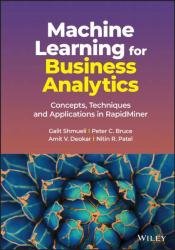 Название: Machine Learning for Business Analytics: Concepts, Techniques and Applications in RapidMiner
Название: Machine Learning for Business Analytics: Concepts, Techniques and Applications in RapidMinerАвтор: Galit Shmueli, Peter C. Bruce
Издательство: Wiley
Год: 2023
Страниц: 701
Язык: английский
Формат: pdf
Размер: 37.6 MB
Machine Learning - also known as data mining or data analytics - is a fundamental part of Data Science. It is used by organizations in a wide variety of arenas to turn raw data into actionable information.
Machine Learning for Business Analytics: Concepts, Techniques and Applications in RapidMiner provides a comprehensive introduction and an overview of this methodology. This best-selling textbook covers both statistical and machine learning algorithms for prediction, classification, visualization, dimension reduction, rule mining, recommendations, clustering, text mining, experimentation and network analytics. Along with hands-on exercises and real-life case studies, it also discusses managerial and ethical issues for responsible use of machine learning techniques.
This is the seventh edition of Machine Learning for Business Analytics, and the first using RapidMiner software. RapidMiner is gaining in popularity among analytics professionals as it is a non-programming environment that lowers the barriers for managers to adopt analytics. The new addition also covers causal analytics as experimentation (often called A/B testing in the industry), which is now becoming mainstream in the tech companies. Further, the authors have added a new chapter on Responsible Data Science, a new part on AutoML, more on deep learning and beefed up deep learning examples in the text mining and forecasting chapters. These updates make this new edition “state of the art” with respect to modern business analytics and AI. Basic knowledge of Python can be helpful for a few chapters.
This edition also includes:
A new co-author, Amit Deokar, who brings experience teaching business analytics courses using RapidMiner
Integrated use of RapidMiner, an open-source machine learning platform that has become commercially popular in recent years
An expanded chapter focused on discussion of deep learning techniques
A new chapter on experimental feedback techniques including A/B testing, uplift modeling, and reinforcement learning
A new chapter on responsible data science
Updates and new material based on feedback from instructors teaching MBA, Masters in Business Analytics and related programs, undergraduate, diploma and executive courses, and from their students
A full chapter devoted to relevant case studies with more than a dozen cases demonstrating applications for the machine learning techniques
End-of-chapter exercises that help readers gauge and expand their comprehension and competency of the material presented
A companion website with more than two dozen data sets, and instructor materials including exercise solutions, slides, and case solutions
The book is divided into nine parts: Part I (Chapters 1–2) gives a general overview of machine learning and its components. Part II (Chapters 3–4) focuses on the early stages of data exploration and dimension reduction. Part III (Chapter 5) discusses performance evaluation. Although it contains only one chapter, we discuss a variety of topics, from predictive performance metrics to misclassification costs. The principles covered in this part are crucial for the proper evaluation and comparison of supervised learning methods.
Part IV includes eight chapters (Chapters 6–13), covering a variety of popular supervised learning methods (for classification and/or prediction). Within this part, the topics are generally organized according to the level of sophistication of the algorithms, their popularity, and ease of understanding. The final chapter introduces ensembles and combinations of methods.
Part V (Chapter 14) introduces the notions of experiments, intervention, and user feedback. This single chapter starts with A/B testing and then its use in uplift modeling and finally expands into reinforcement learning, explaining the basic ideas and formulations that utilize user feedback for learning best treatment assignments.
Part VI focuses on unsupervised learning of relationships. It presents association rules and collaborative filtering (Chapter 15) and cluster analysis (Chapter 16).
Part VII includes three chapters (Chapters 17–19), with the focus on forecasting time series. The first chapter covers general issues related to handling and understanding time series. The next two chapters present two popular forecasting approaches: regression-based forecasting and smoothing methods.
Part VIII presents two broad data analytics topics: social network analysis (Chapter 20) and text mining (Chapter 21). These methods apply machine learning to specialized data structures: social networks and text. The final chapter on responsible data science (Chapter 22) introduces key issues to consider for when carrying out a machine learning project in a responsible way.
Finally, Part IX includes a set of cases.
This textbook is an ideal resource for upper-level undergraduate and graduate level courses in Data Science, predictive analytics, and business analytics. It is also an excellent reference for analysts, researchers, and data science practitioners working with quantitative data in management, finance, marketing, operations management, information systems, computer science, and information technology.
Скачать Machine Learning for Business Analytics: Concepts, Techniques and Applications in RapidMiner